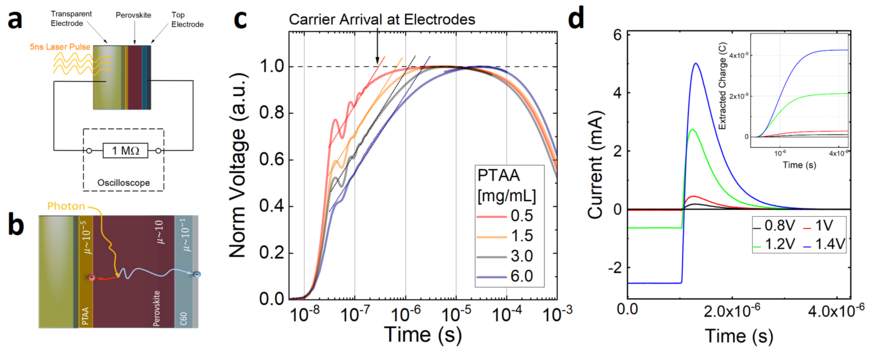Charge extraction and recombination in complete devices
The Soft Matter Physics group and the Perovskite group at the University have a long expertise on electro-optical charge transport measurements. These include electroluminescence, transient photovoltage, bias assisted charge extraction, time of flight, resistance dependent photovoltage, charge extraction by linearly increasing voltage, fast-hysteresis scans, intensity-dependent photocurrent/Voc or time delayed collection field (TDCF). Often, these techniques employ a combination of an optical excitation of the solar cell using a ns-laser pulse and a function generator to apply a time-dependent voltage pulse to the device. An oscilloscope is then employed to visualize the transient response of the cell, allowing to visualize the movement or extraction of charges to the electrodes.
Using these techniques, we can quantify for instance the amount of electric charge present in the device under certain conditions (voltage or illumination), which is an important parameter for our recombination or simulation models.
A second aspect of this research topic that is particularly important to perovskite solar cells, is the study of mobile ions. Perovskite semiconductors are distinct to most other semiconductors due to the large amount of mobile ions (for example I- vacancies, MA+ ions and others). The amount of mobile ions often greatly exceeds the number of active defects states in the material that leads to non-radiative recombination, reflecting the unique, defect tolerant nature of perovskites. However, the ions can cause device instabilities or hysteresis effects. The Perovskite group combines multiple experimental methods to quantify the amount of ions in different types of perovskite solar cells and study their impact on device stability and performance, e.g. through ultrafast fast-hysteresis measurements, or bias assisted charge extraction. The results are then fed back into the numerical models to obtain a more comprehensive understanding of this crucial feature of perovskite solar cells. Find out more!
References
- Zhang, S. et al. The Role of Bulk and Interface Recombination in High‐Efficiency Low‐Dimensional Perovskite Solar Cells. Adv. Mater. 1901090 (2019). doi:10.1002/adma.201901090
- Diekmann, J. et al. Pathways towards 30% efficient perovskite solar cells. (2019). at http://arxiv.org/abs/1910.07422
- Wolff, C. M. et al. Reduced Interface-Mediated Recombination for High Open-Circuit Voltages in CH3NH3PbI3 Solar Cells. Adv. Mater. 29, 1700159 (2017).
- Stolterfoht, M. et al. Approaching the fill factor Shockley–Queisser limit in stable, dopant-free triple cation perovskite solar cells. Energy Environ. Sci. 10, 1530–1539 (2017).
- Paulke, A. et al. Charge carrier recombination dynamics in perovskite and polymer solar cells. Appl. Phys. Lett. 108, (2016).

